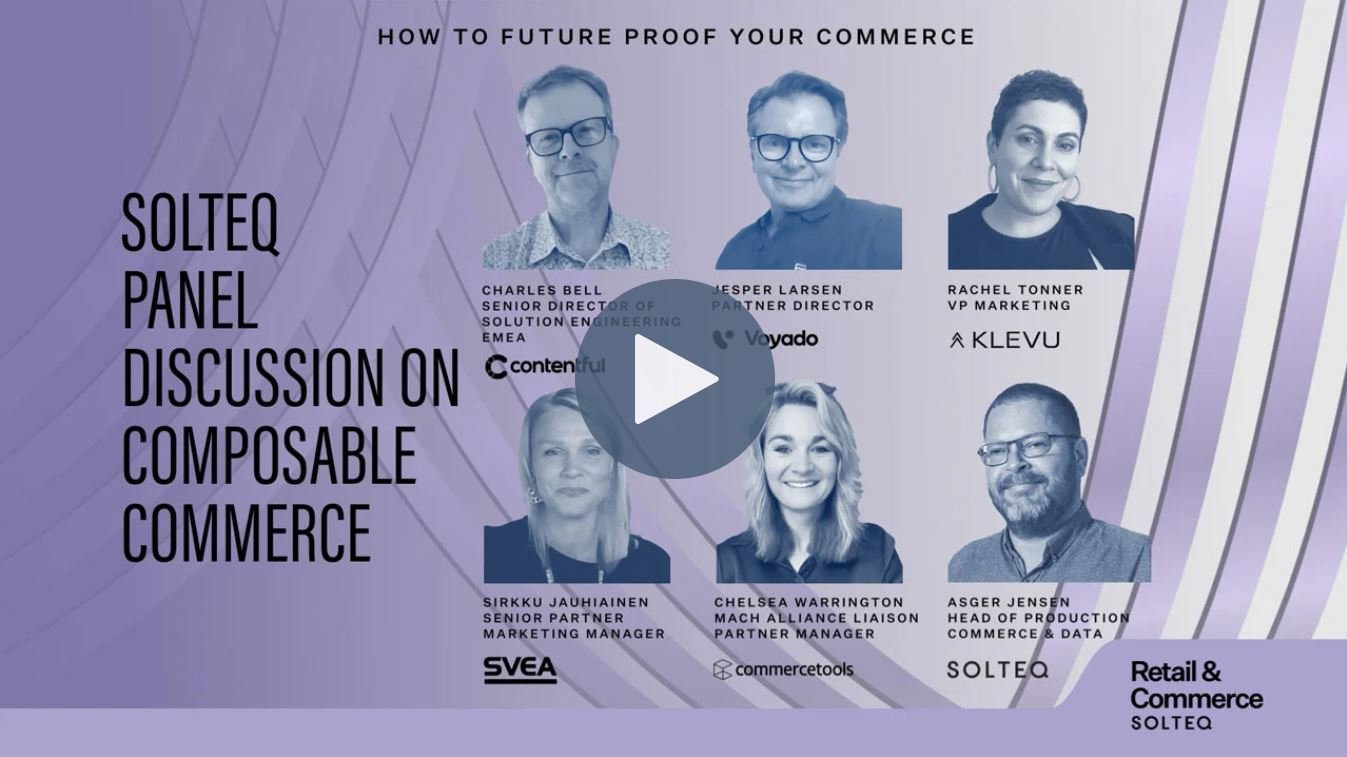Season 1 - Episode 2
🎙️ Simplifying Accessibility: Turning compliance into competitive advantage
The true motivation for improving digital accessibility isn’t about avoiding fines, it’s about prioritizing your users.
In this episode of Simplifiers, host Amel Gaily sits down with Steve Coates, Director of Expert Services at Solteq, to unravel a topic often overlooked: digital accessibility.
Discussed in this episode:
Episode timestamps:
0:03 – 0:42 → Podcast intro by Amel: What is Simplifiers + framing the episode topic
0:44 – 1:47 → Welcome & setup: Accessibility as a business opportunity, not a burden
1:48 – 2:59 → Steve’s background and how accessibility became a core focus
3:01 – 4:55 → What is the European Accessibility Act (EAA) and who does it impact?
5:03 – 6:45 → Why businesses should go beyond compliance: the Black Friday door analogy
6:46 – 7:39 → The timeline: EAA deadline and current state of website compliance
7:47 – 9:44 → What inclusive UX means in practice + design examples
9:47 – 10:43 → Real-world example: designing accessible menus and navigation
10:44 – 12:11 → Solteq’s audit process and identifying design gaps
12:11 – 13:08 → Where should teams focus right now? Starting from foundations
13:15 – 14:55 → Business benefits of accessibility: reach, conversion, and inclusivity
15:15 – 16:09 → Accessibility and UX overlap: better structure, performance, and CX
16:10 – 17:55 → Metrics and accessibility: how to track progress and measure success
17:55 – 19:02 → Missed opportunity: why companies aren’t leveraging accessibility in their messaging
19:03 – 20:02 → Common barriers: cost, tech debt, frameworks, and resource limits
20:03 – 22:04 → Challenges with testing and the need for inclusive testing practices
22:04 – 23:05 → GDPR lessons for EAA compliance: process-driven mindset
23:06 – 24:13 → Industry differences: who is ahead and who is lagging behind
24:14 – 26:14 → Three practical steps for starting accessibility today
26:15 – 27:17 → Is compliance binary? Understanding design nuance and progress
27:18 – 28:15 → Progress over perfection: transparency as a trust signal
28:16 – 30:01 → Accessibility for small businesses: cost-effective tools and flexibility
30:02 – 32:09 → Team collaboration: integrating accessibility across roles
32:10 – 33:17 → Real-world example of success: distributed accessibility at scale
33:18 – 35:10 → The future of accessibility: AI as assistive tech and accelerator
35:11 – 36:05 → The accountability edge: AI exposing non-compliance risks
36:06 – 37:16 → Accessibility is good business, smart design, and the right thing to do
37:17 – 38:14 → Final advice: start with awareness, use what you already have
38:15 – 39:15 → Episode wrap-up: Call to action + next episode teaser (AI & digital humanity)
Episode transcript:
Intro: Welcome to Simplifiers
[Amel]
Simplifiers is the podcast that cuts through the complexity of digital transformation to reveal what works. Created by Solteq, hosted by Amel Gaily, and built for anyone who believes clarity beats complexity—every time.
In this episode, I dive into the world of digital accessibility—not as a legal burden, but as a business advantage. I’m joined by Steve Coates, Director of Expert Services at Solteq, to discuss what the European Accessibility Act really means for digital businesses, and why inclusion is the new frontier of customer experience.
Meet the Guest: Steve Coates
[Steve]
Thank you. It's great to be here.
[Amel]
Before we dive in, could you tell us a bit about your career path and how accessibility became part of your focus?
[Steve]
Certainly. I've been in technology for 15 years, working globally for most of that time, and closely involved in customer experience through technologies like behavior analytics and web analytics. That naturally led us into examining UI/UX and eventually, accessibility.
I worked with IBM and later in the Nordics, where the IT landscape is very dynamic and design-driven. Accessibility became the next logical step once we began analyzing full customer journeys.
Understanding the European Accessibility Act (EAA)
[Amel]
Let’s start with the essentials. What exactly is the European Accessibility Act, and how will it influence e-commerce and digital business?
[Steve]
The EAA is a long-needed set of standards for accessible digital design. It’s not just for e-commerce—it applies to all digital content. With the 2025 compliance deadline nearing, developers and businesses should see this legislation as an opportunity, not a burden.
It’s about ethical design and enabling access for all users, not just a technical checkbox. Businesses should use it as a foundation to build inclusive, high-quality digital services.
[Amel]
Exactly. Even though it’s a legal requirement, why should businesses go beyond compliance?
[Steve]
Great question. Think of a physical store on Black Friday—great deals, great layout, huge line. But you only open the door for half your customers. That’s what a non-accessible website is.
It’s about opening that second door for everyone—disabled or not. Like GDPR, this will require effort, but it’s also an opportunity to improve.
Compliance Deadline and Readiness
[Amel]
Can you tell us more about the timeline?
[Steve]
The deadline is June 28, 2025. That might seem far off, but accessible design takes time. Right now, 70–80% of websites aren’t compliant. The runway is short.
UX and Digital Inclusivity
[Amel]
Let’s talk about UX. What does digital inclusivity mean from the user’s perspective?
[Steve]
Accessible design is about more than standards like WCAG. It’s about ensuring content is structured, readable, and usable by all—from color contrast and layout to screen reader compatibility.
Audits often reveal not just compliance gaps but UX issues. Small design changes can make a huge difference, and they don’t always require massive effort.
Real-World UX Example
[Amel]
Could you share a concrete example?
[Steve]
Menus are a great example. They’re often predictable in layout, but accessibility requires thoughtful navigation and descriptive text for screen readers. Clear design benefits everyone.
Design Criteria and Inclusive Teams
[Amel]
How does Solteq help design teams address broader accessibility?
[Steve]
Our audits cover both compliance and branding alignment. We help teams find UX gaps, like unclear layouts or poor text contrast. We aim to simplify and elevate existing design without breaking visual identity.
First Steps Toward Compliance
[Amel]
What’s the most important discussion teams should be having right now?
[Steve]
Start by understanding your current compliance. Use tools like Lighthouse or browser plugins. You don’t need to solve everything today—just know where you are and build from that foundation.
Business Case for Accessibility
[Amel]
Let’s shift to business value. What are the benefits of prioritizing accessibility?
[Steve]
There are 135 million disabled users in the EU. Accessibility increases your potential customer base and conversion rate. Ethically and economically, it makes sense. It’s not just compliance—it’s smart business.
Overlap With UX and Performance
[Amel]
Is it true that accessibility overlaps with performance and UX?
[Steve]
Absolutely. Accessibility forces structured, thoughtful design—which improves overall UX, site performance, and even SEO. It creates a better launchpad for any digital service.
Measuring the Impact
[Amel]
Can business and accessibility metrics be combined?
[Steve]
You can’t isolate accessible users due to privacy, but you can track conversions and micro-conversions. Ethical promotion of your accessibility improvements can drive traffic and validate design choices.
Missed Opportunities to Promote Compliance
[Amel]
Are companies showcasing their compliance?
[Steve]
Not enough. I’d love to see a GDPR-style badge for accessibility. Some have done the hard work—why not celebrate that? It’s a missed branding and marketing opportunity.
Common Barriers
[Amel]
What are the biggest challenges companies face?
[Steve]
Cost, time, reliance on standard frameworks, and lack of real user testing. Many teams test with able-bodied users, missing true feedback. Foundational integration of accessibility into dev processes is key.
Lessons from GDPR
[Amel]
Can we learn from GDPR?
[Steve]
Yes. GDPR showed us the value of process and mindset. Accessibility is the same. Build procedures that last.
Industry and Regional Differences
[Amel]
Are there differences across regions or industries?
[Steve]
Public services and airlines tend to lead due to regulation. But most verticals are in the same boat—struggling. Some are close; others need structural change.
Three Practical Actions
[Amel]
What 2–3 actions can companies take today?
[Steve]
-
Audit your current compliance (with tools or experts).
-
Identify design and technical gaps.
-
Integrate accessibility into development pipelines (e.g., CI/CD).
It's Not Binary
[Amel]
Is accessibility binary?
[Steve]
The standard checks are yes/no—but real accessibility is a journey. It’s about experience, not just compliance.
Small Businesses and Accessibility
[Amel]
What about small businesses with limited budgets?
[Steve]
Many tools like Canva and site builders have accessibility checkers built in. Small orgs often have simpler sites, so improvements may be easier than expected. For those above 50 users or revenue thresholds, the rules apply.
Team Collaboration
[Amel]
How should design, dev, and content teams align?
[Steve]
Accessibility must be cross-functional—designers, devs, QA, and content creators all play a role. If your QA processes are strong, accessibility becomes just another standard.
Success Stories
[Amel]
Any success stories?
[Steve]
Yes. One client with distributed websites aligned all their teams and became compliant over time. It’s a big lift—but worth celebrating.
Looking Ahead: The Future of Accessibility
[Amel]
Where is accessibility headed?
[Steve]
AI is transforming assistive tools—like Be My Eyes and HandTalk. These will empower users but also increase accountability. If your site isn’t compliant, AI tools will reveal it quickly.
[Amel]
Double-edged sword, then?
[Steve]
Exactly. Great for users, but businesses can’t hide. This pushes compliance forward—which is good for everyone.
Final Advice
[Amel]
For a company taking its first step—where should they start?
[Steve]
Start simple. Use Lighthouse or other tools to understand where you are. Talk to your dev team. If needed, contact experts. What matters most is getting started now.
Closing
[Amel]
Thank you, Steve, for sharing your insights.
Digital accessibility isn’t just a legal requirement—it’s a business and design opportunity. No matter your company size or budget, you can take a step today.
This has been Simplifiers. I'm Amel Gaily. Until next time—keep it simple, keep it human.
In the next episode, we’ll explore the role of AI in digital business and how we can preserve our humanity in an increasingly AI-driven world.









